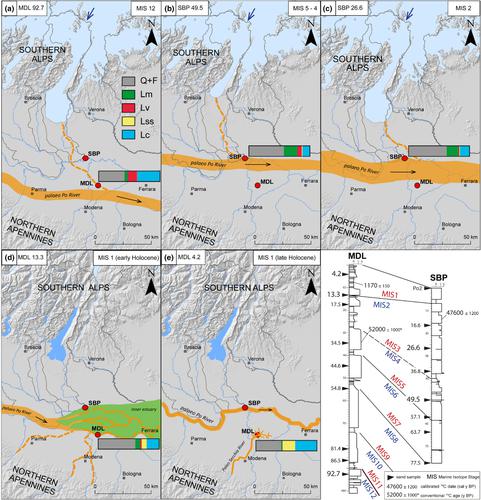当前位置:
X-MOL 学术
›
Basin Res.
›
论文详情
Our official English website, www.x-mol.net, welcomes your
feedback! (Note: you will need to create a separate account there.)
Multi‐source detrital contributions in the Po alluvial basin (northern Italy) since the Middle Pleistocene. Insights into sediment accumulation in intermediate sinks
Basin Research ( IF 2.8 ) Pub Date : 2024-02-20 , DOI: 10.1111/bre.12858 Luca Demurtas 1 , Daniela Fontana 1 , Stefano Lugli 1 , Luigi Bruno 1
Basin Research ( IF 2.8 ) Pub Date : 2024-02-20 , DOI: 10.1111/bre.12858 Luca Demurtas 1 , Daniela Fontana 1 , Stefano Lugli 1 , Luigi Bruno 1
Affiliation

|
Integrated stratigraphic‐compositional studies on alluvial successions provide a valuable tool to investigate the provenance of detritus in multi‐source systems. The Po Plain is an intermediate sink of the Po‐Adriatic source‐to‐sink system, fed by rivers draining two orogens. The Alps are characterized by extensive outcrops of plutonic‐metamorphic and ultramafic rocks to the north‐west and of Mesozoic carbonates to the east (Southern Alps). The Northern Apennines, to the south, are dominated by sedimentary successions. The Po River flows from the Western Alps to the Adriatic Sea, interacting with a dense network of transverse tributaries that drain the two orogens. Stratigraphic, sedimentological and compositional analyses of two 101 and 77.5 m‐long cores, recovered from the Central Po Plain, reveal the stacking of three petrofacies, which reflects distinct provenance and configurations of the fluvial network. A South‐Alpine sedimentary input between MIS 12 and MIS 10 is testified by petrofacies 1, characterized by carbonate‐ and volcanic‐rich detritus from rocks exposed in the Southern Alps. A northward shift of the Po River of more than 30 km is marked by a quartz‐feldspar and metamorphic‐rich detritus (petrofacies 2), similar to modern Po River sands. This dramatic reorganization of the fluvial network likely occurred around MIS 9–MIS 8 and is possibly structurally controlled. A further northward shift of the Po River and the onset of Apennine sedimentation in the Late Holocene is revealed by petrofacies 3, rich in sedimentary lithics from the Apennine successions. The results of this study document how compositional analysis, if framed in a robust stratigraphic picture, may provide clues on the evolution of multi‐source alluvial systems.
中文翻译:

中更新世以来波冲积盆地(意大利北部)的多源碎屑贡献。深入了解中间汇沉积物积累
冲积层序的综合地层成分研究为研究多源系统中碎屑的来源提供了一个有价值的工具。波河平原是波亚得里亚海源汇系统的一个中间汇,由排出两个造山带的河流供水。阿尔卑斯山的特点是西北部有大量的深成变质岩和超镁铁岩露头,东部有中生代碳酸盐岩(南阿尔卑斯山)。南部的北亚平宁山脉以沉积层序为主。波河从西阿尔卑斯山流向亚得里亚海,与排出两个造山带的密集的横向支流网络相互作用。对从波中部平原回收的两个 101 米和 77.5 米长的岩心进行地层学、沉积学和成分分析,揭示了三种岩相的堆积,反映了河流网络的不同来源和构造。岩相 1 证实了 MIS 12 和 MIS 10 之间的南阿尔卑斯沉积输入,其特征是来自南阿尔卑斯山暴露的岩石的富含碳酸盐和火山碎屑。波河向北移动了 30 多公里,以石英长石和富含变质岩的碎屑(岩相 2)为标志,与现代波河砂相似。河流网络的这种戏剧性重组可能发生在 MIS 9-MIS 8 周围,并且可能受到结构控制。岩相 3 揭示了波河进一步向北移动和亚平宁沉积在全新世晚期开始,岩相 3 富含来自亚平宁层序的沉积岩屑。这项研究的结果记录了成分分析(如果以稳健的地层图片为框架)如何为多源冲积系统的演化提供线索。
更新日期:2024-02-20
中文翻译:

中更新世以来波冲积盆地(意大利北部)的多源碎屑贡献。深入了解中间汇沉积物积累
冲积层序的综合地层成分研究为研究多源系统中碎屑的来源提供了一个有价值的工具。波河平原是波亚得里亚海源汇系统的一个中间汇,由排出两个造山带的河流供水。阿尔卑斯山的特点是西北部有大量的深成变质岩和超镁铁岩露头,东部有中生代碳酸盐岩(南阿尔卑斯山)。南部的北亚平宁山脉以沉积层序为主。波河从西阿尔卑斯山流向亚得里亚海,与排出两个造山带的密集的横向支流网络相互作用。对从波中部平原回收的两个 101 米和 77.5 米长的岩心进行地层学、沉积学和成分分析,揭示了三种岩相的堆积,反映了河流网络的不同来源和构造。岩相 1 证实了 MIS 12 和 MIS 10 之间的南阿尔卑斯沉积输入,其特征是来自南阿尔卑斯山暴露的岩石的富含碳酸盐和火山碎屑。波河向北移动了 30 多公里,以石英长石和富含变质岩的碎屑(岩相 2)为标志,与现代波河砂相似。河流网络的这种戏剧性重组可能发生在 MIS 9-MIS 8 周围,并且可能受到结构控制。岩相 3 揭示了波河进一步向北移动和亚平宁沉积在全新世晚期开始,岩相 3 富含来自亚平宁层序的沉积岩屑。这项研究的结果记录了成分分析(如果以稳健的地层图片为框架)如何为多源冲积系统的演化提供线索。






























 京公网安备 11010802027423号
京公网安备 11010802027423号